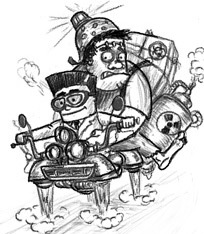How to line up getting feedback if you have points from here to Yuzhno-Sakhalinsk

Last time I was asked how you can control the stores for 1500 kilometers from Moscow and beyond. Obviously, no way. There are classic methods, but they do not really work. Fortunately - we can safely project Internet methods to the physical retail here too.
If you think about the essence of the problem in obtaining objective feedback. The problem is actually quite old and well known. The classic challenge is this: you are the mayor of the city. You need to be aware of the problems that you can solve. The better you solve them - the greater the chance that you will be elected mayor again. And the city for you is not only “clients” going to elections, but also a direct knowledge base for feedback. Each person is an experience to use.
')
Accordingly, in the case of a retail network:
- Ignorance of the bugs of individual points means a direct loss of profit.
- If someone mows too much, he exposes the entire network throughout the country.
- A lot of points, distance and distance - this is what prevents direct control, as is the case with shops in Moscow.
First, let's see how the point control system works.
1. Personal presence
It is clear that the best option is to go and buy yourself. But in case the store is somewhere far away, it is somewhat complicated to do. Therefore, the classic control system is “mysterious customers”, that is, special people who enter the store and take off about a hundred parameters in the course of dialogue, choice, inspection of the place and the subsequent transaction. They then send us all the sales documents. These guys need to be sent to both their and competitors.
2. Request for reports
Actual reports are pieces that allow you to go to the store. For example, a photo report with a point allows you to assess the correctness of the layout and placement of all elements of outdoor advertising at the entrance. A report on the game stores and other advertising activity allows you to keep abreast of how well everything goes. In general, with the invention of photography, distorting facts has become more difficult. One picture often says more than a hundred lines of letters.
3. Automatic reading of indicators
In IT, you can compare the average amount of goods in a check, the average size of a check and the average number of checks per day. Observing the dynamics of these indicators (and a dozen such as changes in sales of goods of group A) by weeks, you can evaluate the work point. For example, we know for sure that if the amount of goods in a check falls by 11% of the norm, then someone from the shift stops playing with the customers in the store. And so on, up to checking such specific things as the ratio of issued checks to spent packages and so on.
4. Regular reviews
After ordering, we send a letter reminding you that the rules for purchased games can always be downloaded from us, plus we ask you to leave feedback about the product or store. Here or on Ya. Market.
And this review is very valuable. It helps to understand exactly what happened with a specific order. At the same time, the value of a negative review (despite the negativity associated with it) is higher — it shows a bug that dozens more people would have encountered before it was found.
Regular reviews are also a book of reviews. We put right on the counter a book on which the request to leave an opinion or idea is directly written. Anything happens:
One of the readers:

Here is a completely incomprehensible example:

On the one hand chat, on the other - what happens if the buyer finds markers:

And here is a man waiting for gift wrapping:

5. Social networks - direct graph
It's simple. Customize the search for messages on the mention of the company and products (where they can be separated from the information flow). And listen carefully. There are you in social networks, there is no you - it does not matter. There your customers, and they carry you to each other. If you were good - they say well about you. If you grunt - they talk about you badly without embarrassment.
Usually you come across our announcements or something like an example below, that without knowing the game you cannot make out, but sometimes direct instructions on what to improve.

That's how we learn new properties of the product. If we need additional advertising or an idea for a poster in the subway - here it is, ready:

This also goes to the tracking tape:

When you see a direct review, you can thank for the positive from the corporate account, and by negative - at least specify the details. Because in social networks rarely there is something like “I bought such and such goods from the company N, order No. 5125, something happened during delivery” - more often the client first swears in a state of frustration that is not very coherent. And here sometimes he can ask for details, and sometimes you just have to guess. Or “I went to Mosigra today, the sellers are just a miracle!” - and where it is, what kind of store is incomprehensible. Therefore, one of our employees is engaged in just such network detectives.
6. Social networks - reverse graph
But this is the coolest. If you often write about how your company works and how everything should happen, readers begin to understand what to expect. For example, you know exactly what to expect from buying from us. And if somewhere something is wrong, you know who to write to me. Because I told you about how it should be. And because it is easier to reach the PM on Habré than to look for someone's mail in the region, for example.
So, the mechanics: talk about your work, and you will be helped by bug reports.
General moments
- Bugreport is positive. Despite the fact that the wording is often not the most polite, if you hadn’t been told about the joint, you would have learned about it from financial losses, and then would have spent time and energy on finding a problem.
- The customer is not always right. In general, we set democratic rules, but we strictly follow them. I can tell a couple of strange examples in the comments.
- You need to be ready to fix really weird things. For example, the work of the Post of the Russian Federation - I already wrote about this in the review of specific cases .
- Understand when the "bug" is not necessary to touch: for example, we are often asked to make delivery from stores. We tried, not worth it.
- Not all bugs are urgent. You can use the standard assessment methodology on three scales: “urgent-non-urgent”, “quickly fix or take a long time to implement” and “this will give a tangible result - will not give”.
Request
If you know what can be done better in one of our stores, you want to note that someone from the vendors or animators is awesome, or you have found a bug, write me in a personal or at fox@mosigra.ru. This will help a lot.
Source: https://habr.com/ru/post/226277/
All Articles